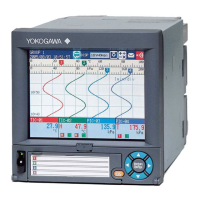6
IM 04L41B01-18E
What the DX Can Do
TheDXprovidesthefollowingfunctions:
• ParticipateinanEtherNet/IPnetworkasanAdapter(Server).
• Communicate with new and old Allen-Bradley PLCs such as MicroLogix,
CompactLogix,ControlLogix,SLC500,PLC-5,andPLC-2.
• SupportbothExplicitandI/Omessages.
• PLCscanaccessinternaldataoftheDX.
Data Access
Measurement channel data Read
Computationchannel
*1
data Read
Communicationinputdata
*1*2
Read/write
External input channel data
*3
Read/write
*1Optional(/M1and/PM1).
*2Communicationinputdata,ifcodedinacalculationexpressioninthecomputationchannel,
can be displayed on the DX.
*3Thisfunctionis
availableonlyontheDX2000.Optional(/MC1).
The following shows examples of usage.
• DataondevicesonanetworkcanberecordedbyaPLCtotheDX.
• DatameasuredbytheDXcanbeacquiredbyaPLC.
Settings of the DX
TheDXisreadytouseafterthefollowingsettingshavebeenmade.
• IP address and other settings required to connect to Ethernet
• EnablingofEtherNet/IPserverfunction
Access to the DX
TheDXisapassivedeviceonanEthernetnetwork.TheDXcannotlauncharequest.A
PLClaunchesarequesttotheDX.
A request is called a "message". There are two message types: Explicit message and
I/Omessages(Implicitmessage).AnExplicitmessage,includedincontrollogic,isused
to access the DX, only when required, and transmit data.An I/O message is used to
transmitpre-specifiedDXdataatintervals.
TheDXsupportscommunicationswithold-modelAllen-BradleyPLCsnotcompatiblewith
EtherNet/IP.The DX can also communicate with PLCs compatible with Programmable
Controller Communication Command (PCCC) using conversion of PCCC to EtherNet/
IP at the gateway.PCCC refers to serial communications that are also called DF1
communications.
The DX supports EtherNet/IP in which PCCC requests are encapsulated. It can
communicatealsowithPLCsthatsupportencapsulatedPCCC.
Introduction of Features

